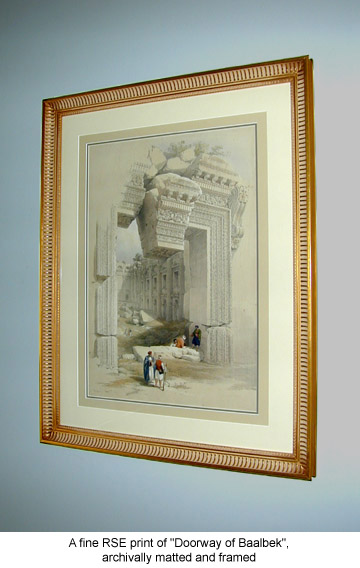
The prints are first rinsed in a water bath to allow measuring of the initial paper pH, and to raise this pH above 7.5 before bleaching. It is thought that damage to the paper fibers during bleaching occurs when paper with a pH of less than 7.0 is placed directly into a bleach solution and passes through pH 7.0 during the bleaching process.
Once the pH is adjusted to over 7.5, the prints are placed in a .5% calcium hypochlorite solution for anywhere from 5 minutes to 15 minutes, with the objective being the minimum treatment which will remove the foxing and other discoloration. The prints are then rinsed in at least three different water baths to achieve a final paper pH of 8.0-8.5. Very dilute Citric Acid is used as an "anti-chlor", and to lower the rinse water baths to pH 7.0 or so at the beginning of each rinse. Rinsing requires anywhere from 6 to 12 hours to reduce the paper pH to the proper level after bleaching. It is extremely important to remove all of the bleach residue. Using Calcium Hypochlorite and Calcium Hydroxide also gives the paper a bit of a "calcium reserve", or buffer, to prevent later acidification.
The prints are then pressed between a series of very heavy cotton blotters
to dry - this usually takes 1-2 days of pressing. On occasion a print will initally
be a bit "wavy" after cleaning due to the wood pulp content of the paper, but
this is quite minor and typically is not a problem with prints that are matted
and framed. Overall, prints cleaned using this method have displayed no further
fading and no noticeable further deterioration.
 Light,
moisture and acidity are the enemies of lithographs, and should be avoided in
storage locations insofar as possible. Prints should be kept in acid free archival
boxes or drawers, with acid free papers between the prints if stored in a stack.
Prolonged exposure to sunlight or strong artificial light should be minimized,
and exposure to moisture avoided entirely.
Light,
moisture and acidity are the enemies of lithographs, and should be avoided in
storage locations insofar as possible. Prints should be kept in acid free archival
boxes or drawers, with acid free papers between the prints if stored in a stack.
Prolonged exposure to sunlight or strong artificial light should be minimized,
and exposure to moisture avoided entirely.
In framing Roberts Prints, only acid free matting and framing materials should be used. Exposure to matting containing acid may darken the covered areas of the print. UV resistant glass or plastic is highly recommended, to prevent fading and deterioration. In many cases the prints have been stored in a folio until very recently, with only very infrequent viewing. The colors may look bright now, but prolonged exposure to sunlight will fade them substantially over time.
At right is an example of an RSE print properly framed using triple acid free matting and UV blocking Museum Glass. This can be a somewhat expensive procedure, but the preservation of these increasingly scarce and valuable prints justifies such careful treatment.